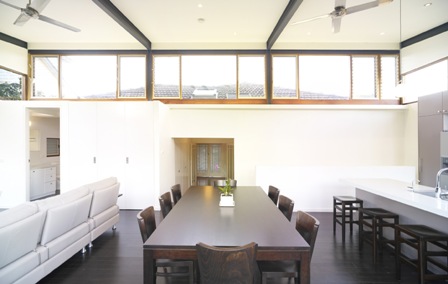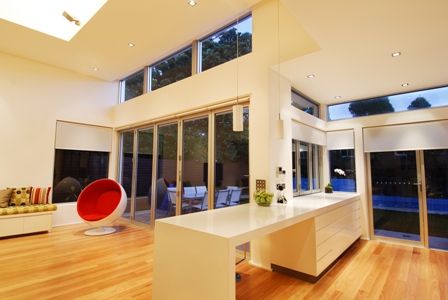 Despite being an ancient architectural element often seen in churches and cathedrals, clerestory windows have been modernised and are becoming more popular, especially in high-end residential developments. Danielle Bowling reports.
Despite being an ancient architectural element often seen in churches and cathedrals, clerestory windows have been modernised and are becoming more popular, especially in high-end residential developments. Danielle Bowling reports.
While clerestory win dows have obvious aesthetic advantages, both from within and outside the property, there are a number of other benefits of having them installed in new or existing homes.
Technically defined as a raised sec tion of the roof of a house or other buildings with windows to admit light, Carol Marra, partner at archi tectural firm Marra + Yeh, describes a clerestory window as one which “is high up. It's not at eye level, but it's near the ceiling area of a room.”
Having windows up high or at ceil ing level means that security is less of an issue for those who are keen to keep fresh air coming in during the evening or when the house is empty. Being able to keep them open more often means the house will have a more easily regulated indoor tempera ture, reducing the need for air-condi tioning or other less environmentally- friendly heating and cooling options.
“Usually, when we look at whether clerestory windows are an appropri ate component, one of the reasons why we might use them is because depending on the height of the room or the proportions of the room, hav ing windows which are high up can bring in light which falls onto the ceiling plane rather than onto a work surface and so it can improve the daylighting quality within a room,” Marra says.
“The other reason might be because of cross ventilation purposes. So sometimes when you're trying to cross ventilate a room, it works well to have one window which is low and one window which is high so that air flow moves into the room and then up through the room and out at a higher level. So it actually displaces the hot air which congregates towards the ceiling, because hot air rises.”

The only situation in which clerestory windows would not be appropriate to install, Marra says, would be when servi cability is important. The downside to having the security of high windows is that they are more difficult to reach and therefore clean, but as many people don't clean the outside of their windows very often, Marra doesn't see this as much of a concern.
The majority of clerestory windows installed in residential developments are glazed, which, according to Murray Chaloner, architectural specification and commercial support at Architectural Window Systems (AWS), simply adds to the windows' temperature regulation properties.
“They let heat out. They control the amount of cross ventilation that is occurring and obviously when they're closed they can retain the ambient tem perature inside,” he says. “They need to be glazed, otherwise you have water and wind coming in. Generally, people are combining them with low-E glass or high performance glazing to lessen the impact of heat transfer or cold transfer and to retain the ambient temperature.”
Clerestory windows are often being installed in the form of louvres and awning-type windows and can be operated either manually or auto matically.
“If you have louvres up there you'd have a map rod stuck away in your cupboard and you’d just pull it out when you want to open and close the louvres,” Chaloner says.
“Alternative to that, you can hit a button on the wall or it can be linked in with your building man agement system or your cbus sys tem, but the beauty of having some thing automated like that is that they can be coupled with tempera ture sensors and rain sensors, so if it does start to rain outside they’ll automatically close, or if the tem perature up in that area gets to a certain level, they'll automatically open to vent the building.”
Clerestory windows were incorpo rated into the extension of a house in Bencoolen Avenue in Sydney's northwest, designed by Marra + Yeh and built by Avex Building Services. The brief was to rejuvenate the pre- war bungalow and roughly double its floorspace with an “environmen tally appropriate” addition, which resulted in a light filled living space.
Sustainability was a key considera tion when determining the building materials and methods of construc tion for the project. North-facing win dows allowed the penetration of light during winter months; the steel struc ture minimised the overall material use, transport and processing and has a high recycled content; and the house’s high ceilings, clerestory win dows and ceiling fans assist in passive cooling and cross-ventilation.
James Chan, project manager at Avex, had not previously installed clerestory windows before working on this extension, but was pleased with the end result, despite the tricky installation process.
“It was quite difficult to install in terms of all the other surfaces,” he says. “With the windows on all four sides, we didn’t have a clear cavity to run all the electrical and what have you. Installation-wise, it was not conventional. Where normally you would stick [the window] next to a brick wall or a timber wall, we had to attach it to structural poles.
“Having said that, the sizes had to be spot on for the windows because there were a lot of structur al poles where once installed, you couldn't move them around, where as with timber and brick you can pack it out.”
Despite all the advances that have been made in the building industry, especially in terms of sus tainability, clerestory windows prove that simple, old fashioned design elements have held their ground and proved to be just as useful, if not more, in today's modern, tech nology-savvy homes.

